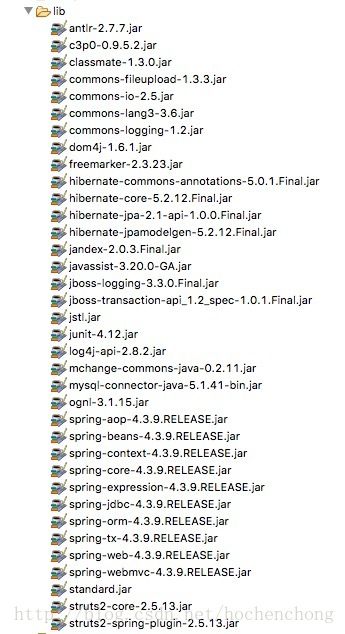SSH 环境搭建及注解实现登录功能 DEMO
SSH 环境搭建及注解实现登录功能 DEMO
前言
最近通过网上的视频学习了一下 SSH 三大框架的整合应用,熟悉一下流程,视频其实三四天就可以看完了。比较基础的内容,更多的是需要自己去尝试,离开视频后一步步去操作,去实践。
环境
Eclipse 4.7.1
Windows 7
Spring 4.3.9 版本
Struts 2.5 版本
Hibernate 5.2.12 版本
C3P0 0.9.5.2 版本
MySQL 驱动 5.1.41
struts2-spring-plugin-2.5.13.jar
说明版本只是因为,不同版本配置可能有所不同,自己配置的时候,因为 jar 包都是从官网下载,所以版本都比较新。配置起来有所不同,同时有些使用的方法也可能被废弃了。
配置
新建 web 项目
导入相关的 jar 包
配置文件的配置
编写后台代码
前台页面
测试
新建 web 项目
打开 Eclipse,File —— New —— Dynamic Web project,输入项目名称,然后 Finally
导入相关的 jar 包
导入最基础的 jar 包即可,缺包的再导入相关的 jar 包
Struts2 的官网有提供必须的最小 jar 包
Hibernate 则导入 required 文件夹下的 jar 包和 jpa 文件夹下的 jar 包
Spring 的 jar 包(需要导入 spring-orm-4.3.9.RELEASE.jar 与 Hibernate 整合)
mysql 驱动的 jar 包
导入 Struts2 与 Spring 整合的插件包 struts2-spring-plugin-2.5.13.jar
导入 c3p0-0.9.5.2.jar
配置文件的配置
web.xml 配置
在 /ssh_anno(项目名)/WebContent/WEB-INF 下创建一个 web.xml 文件。配置如下:
<web-app xmlns:xsi="http://www.w3.org/2001/XMLSchema-instance"
xmlns="http://xmlns.jcp.org/xml/ns/javaee"
xsi:schemaLocation="http://xmlns.jcp.org/xml/ns/javaee http://xmlns.jcp.org/xml/ns/javaee/web-app_3_1.xsd"
id="WebApp_ID" version="3.1">
<display-name>ssh_annodisplay-name>
<welcome-file-list>
<welcome-file>/WEB-INF/login.jspwelcome-file>
welcome-file-list>
<listener>
<listener-class>org.springframework.web.context.ContextLoaderListenerlistener-class>
listener>
<context-param>
<param-name>contextConfigLocationparam-name>
<param-value>classpath:applicationContext.xmlparam-value>
context-param>
<filter>
<filter-name>struts2filter-name>
<filter-class>org.apache.struts2.dispatcher.filter.StrutsPrepareAndExecuteFilterfilter-class>
filter>
<filter-mapping>
<filter-name>struts2filter-name>
<url-pattern>/*url-pattern>
filter-mapping>
web-app>applicationContext.xml 配置
在 src 下创建 applicationContext.xml 文件,配置如下:
<beans xmlns="http://www.springframework.org/schema/beans"
xmlns:xsi="http://www.w3.org/2001/XMLSchema-instance"
xmlns:p="http://www.springframework.org/schema/p"
xmlns:context="http://www.springframework.org/schema/context"
xmlns:tx="http://www.springframework.org/schema/tx"
xsi:schemaLocation="http://www.springframework.org/schema/beans
http://www.springframework.org/schema/beans/spring-beans.xsd
http://www.springframework.org/schema/context
http://www.springframework.org/schema/context/spring-context-4.3.xsd
http://www.springframework.org/schema/tx
http://www.springframework.org/schema/tx/spring-tx-4.3.xsd">
<bean id="dataSource" class="com.mchange.v2.c3p0.ComboPooledDataSource">
<property name="driverClass" value="com.mysql.jdbc.Driver" />
<property name="jdbcUrl" value="jdbc:mysql://localhost:3306/learnSSH?characterEncoding=UTF-8" />
<property name="user" value="root" />
<property name="password" value="123456" />
bean>
<context:component-scan base-package="test" />
<bean id="sessionFactory" class="org.springframework.orm.hibernate5.LocalSessionFactoryBean">
<property name="dataSource" ref="dataSource">property>
<property name="configLocations" value="classpath:hibernate.cfg.xml">property>
<property name="packagesToScan" value="test.entity">property>
bean>
<bean id="transactionManager" class="org.springframework.orm.hibernate5.HibernateTransactionManager">
<property name="sessionFactory" ref="sessionFactory">property>
bean>
<tx:annotation-driven transaction-manager="transactionManager" />
<bean id="hibernateTemplate" class="org.springframework.orm.hibernate5.HibernateTemplate">
<property name="sessionFactory" ref="sessionFactory">property>
bean>
beans>修改 applicationContext.xml 配置中的数据库名称,账号以及密码,数据库必须存在。Hibernate 可以配置自动创建对应的表,但是无法自动创建数据库。
hibernate.cfg.xml 文件配置
<hibernate-configuration>
<session-factory>
<property name="hibernate.show_sql">trueproperty>
<property name="hibernate.format_sql">trueproperty>
<property name="hibernate.hbm2ddl.auto">updateproperty>
<property name="hibernate.dialect">org.hibernate.dialect.MySQL5Dialectproperty>
session-factory>
hibernate-configuration>struts.xml 配置
<struts>
<package name="front" namespace="/" extends="struts-default">
<global-allowed-methods>regex:.*global-allowed-methods>
<action name="user_*" class="userAction" method="{1}">
<result name="loginSuccess">/WEB-INF/hello.jspresult>
<result name="login">/WEB-INF/login.jspresult>
action>
package>
struts>编写后台代码
编写实体类 User.java
在 src 下创建包 test.entity,然后创建 User.java 文件,代码如下:
package test.entity;
import javax.persistence.Column;
import javax.persistence.Entity;
import javax.persistence.GeneratedValue;
import javax.persistence.GenerationType;
import javax.persistence.Id;
import javax.persistence.Table;
@Entity
@Table(name="t_user")
public class User {
@Id
@GeneratedValue(strategy=GenerationType.IDENTITY)
private int uid;
@Column
private String username;
@Column
private String password;
@Column
private String address;
public int getUid() {
return uid;
}
public void setUid(int uid) {
this.uid = uid;
}
public String getUsername() {
return username;
}
public void setUsername(String username) {
this.username = username;
}
public String getPassword() {
return password;
}
public void setPassword(String password) {
this.password = password;
}
public String getAddress() {
return address;
}
public void setAddress(String address) {
this.address = address;
}
}UserAction.java 代码编写
在 src 下创建包 test.action,然后创建 UserAction.java 文件,代码如下:
package test.action;
import javax.annotation.Resource;
import javax.servlet.http.HttpServletRequest;
import org.apache.struts2.ServletActionContext;
import org.springframework.context.annotation.Scope;
import org.springframework.stereotype.Controller;
import com.opensymphony.xwork2.ActionSupport;
import test.entity.User;
import test.service.UserService;
@Controller("userAction")
@Scope(value="prototype")
public class UserAction extends ActionSupport {
@Resource(name="userService")
private UserService userService;
private String username;
private String password;
public String getUsername() {
return username;
}
public void setUsername(String username) {
this.username = username;
}
public String getPassword() {
return password;
}
public void setPassword(String password) {
this.password = password;
}
// 登录
public String login() {
User user = new User();
user.setUsername(username);
user.setPassword(password);
User userExist = userService.login(user);
if (null != userExist) {
HttpServletRequest request = ServletActionContext.getRequest();
request.getSession().setAttribute("user", userExist);
return "loginSuccess";
} else {
return "login";
}
}
}UserService.java 代码编写
在 src 下创建包 test.service,然后创建 UserService.java 文件,代码如下:
package test.service;
import javax.annotation.Resource;
import org.springframework.stereotype.Service;
import org.springframework.transaction.annotation.Transactional;
import test.dao.UserDao;
import test.entity.User;
@Service(value="userService")
@Transactional
public class UserService {
@Resource(name="userDao")
private UserDao userDao;
// 登录验证
public User login(User user) {
return userDao.login(user);
}
}UserDao.java 和 UserDaoImpl.java 代码编写
在 src 下创建包 test.dao,然后创建 UserDao.java 和 UserDaoImpl.java 文件,代码如下:
UserDao.java
package test.dao;
import test.entity.User;
public interface UserDao {
// 登录验证
User login(User user);
}UserDaoImpl.java
package test.dao;
import java.util.List;
import javax.annotation.Resource;
import org.springframework.orm.hibernate5.HibernateTemplate;
import org.springframework.stereotype.Component;
import test.entity.User;
@Component("userDao")
public class UserDaoImpl implements UserDao {
@Resource(name="hibernateTemplate")
private HibernateTemplate hibernateTemplate;
// 登录
@SuppressWarnings("unchecked")
@Override
public User login(User user) {
List list = (List) hibernateTemplate.
find("from User where username=? and password=?", user.getUsername(),user.getPassword());
if (null != list && list.size() > 0) {
return list.get(0);
}
return null;
}
}
前台页面
在 /ssh_anno/WebContent/WEB-INF/ 下创建 login.jsp 和 hello.jsp 页面
login.jsp
<%@ page language="java" contentType="text/html; charset=utf-8"
pageEncoding="utf-8"%>
<html>
<head>
<meta http-equiv="Content-Type" content="text/html; charset=UTF-8">
<title>登录页面title>
head>
<body>
<form action="${pageContext.request.contextPath}/user_login.action" method="post">
<br />
<br />
用户名:<input type="text" id="username" name="username" /> <br />
密码:<input type="password" id="password" name="password" /> <br />
<button type="submit">提交button>
form>
body>
html>hello.jsp
<%@ page language="java" contentType="text/html; charset=UTF-8"
pageEncoding="utf-8"%>
<html>
<head>
<meta http-equiv="Content-Type" content="text/html; charset=UTF-8">
<title>Hello,SSHtitle>
head>
<body>
<h1>Hello,${user.username}h1>
body>
html>测试
在 MySQL 中创建数据库,这里数据库名为 learnSSH。与 applicationContext.xml 中的配置保持一致即可。
运行项目,则会自动在 learnSSH 数据库中创建表 t_user
手动往里面输入一条记录,例如用户名为 test,密码为 123
在 http://localhost:8080/ssh_anno/ 页面,输入刚才的账号密码,点击登录,成功跳转到 hello.jsp 页面的内容。
OK,测试成功!
后记
到此,基本整合就结束了,剩下的就是往上面新增一些功能了。加入注解之后,整个开发变得更为整洁了,也方便了许多。
关于 SSH 的了解,估计也就到此告一段落了,之后则去折腾其他的,如今更多的是使用 SSM 或者其他的。了解多一套框架,以此来扩展自己的知识面。在遇到新老项目对接的时候,不至于什么都不懂,自己实践后,留个小 DEMO 并做下笔记。需要用到时,翻看一下自己的笔记和 DEMO,也就很快就上手了。
在实践中成长!
HochenChong
时间:2017-12-21
